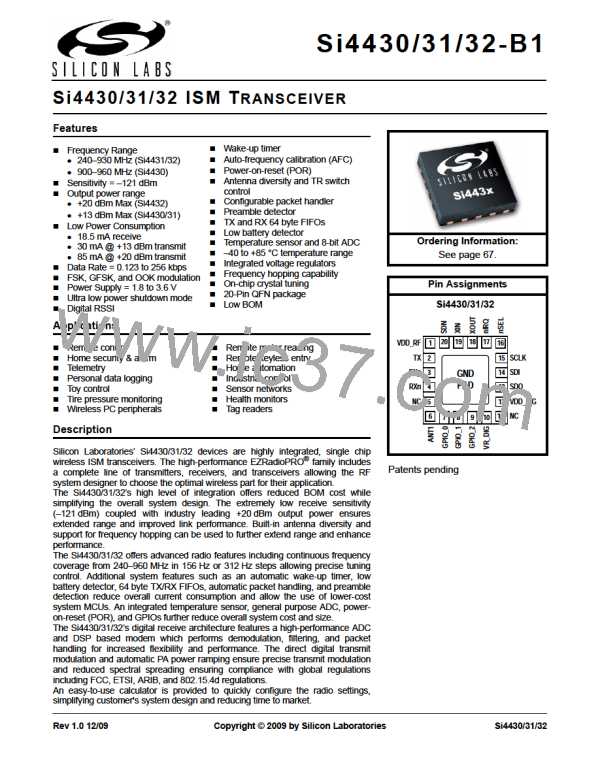Si4430/31/32-B1
4.2. Modulation Data Source
The Si4430/31/32 may be configured to obtain its modulation data from one of three different sources: FIFO mode,
Direct Mode, and from a PN9 mode. In Direct Mode, the TX modulation data may be obtained from several
different input pins. These options are set through the dtmod[1:0] field in "Register 71h. Modulation Mode Control
2".
D7
D6
D5
D4
D3
D2
D1
D0
POR Def.
Add R/W Function/Description
71 R/W
Modulation Mode
Control 2
trclk[1] trclk[0] dtmod[1] dtmod[0] eninv fd[8] modtyp[1] modtyp[0]
00h
dtmod[1:0]
Data Source
00
01
10
11
Direct Mode using TX/RX Data via GPIO pin (GPIO configuration required)
Direct Mode using TX/RX Data via SDI pin (only when nSEL is high)
FIFO Mode
PN9 (internally generated)
4.2.1. FIFO Mode
In FIFO mode, the transmit and receive data is stored in integrated FIFO register memory. The FIFOs are
accessed via "Register 7Fh. FIFO Access," and are most efficiently accessed with burst read/write operation as
discussed in "3.1. Serial Peripheral Interface (SPI)" on page 18.
In TX mode, the data bytes stored in FIFO memory are "packaged" together with other fields and bytes of
information to construct the final transmit packet structure. These other potential fields include the Preamble, Sync
word, Header, CRC checksum, etc. The configuration of the packet structure in TX mode is determined by the
Automatic Packet Handler (if enabled), in conjunction with a variety of Packet Handler Registers (see Table 13 on
page 45). If the Automatic Packet Handler is disabled, the entire desired packet structure should be loaded into
FIFO memory; no other fields (such as Preamble or Sync word are automatically added to the bytes stored in FIFO
memory). For further information on the configuration of the FIFOs for a specific application or packet size, see "6.
Data Handling and Packet Handler" on page 41.
In RX mode, only the bytes of the received packet structure that are considered to be "data bytes" are stored in
FIFO memory. Which bytes of the received packet are considered "data bytes" is determined by the Automatic
Packet Handler (if enabled), in conjunction with the Packet Handler Registers (see Table 13 on page 45). If the
Automatic Packet Handler is disabled, all bytes following the Sync word are considered data bytes and are stored
in FIFO memory. Thus, even if Automatic Packet Handling operation is not desired, the preamble detection
threshold and Sync word still need to be programmed so that the RX Modem knows when to start filling data into
the FIFO. When the FIFO is being used in RX mode, all of the received data may still be observed directly (in real-
time) by properly programming a GPIO pin as the RXDATA output pin; this can be quite useful during application
development.
When in FIFO mode, the chip will automatically exit the TX or RX State when either the ipksent or ipkvalid interrupt
occurs. The chip will return to the IDLE mode state programmed in "Register 07h. Operating Mode and Function
Control 1". For example, the chip may be placed into TX mode by setting the txon bit, but with the pllon bit
additionally set. The chip will transmit all of the contents of the FIFO and the ipksent interrupt will occur. When this
interrupt event occurs, the chip will clear the txon bit and return to TUNE mode, as indicated by the set state of the
pllon bit. If no other bits are additionally set in register 07h (besides txon initially), then the chip will return to the
STANDBY state.
In RX mode, the rxon bit will be cleared if ipkvalid occurs and the rxmpk bit (RX Multi-Packet bit, SPI Register 08h
bit [4]) is not set. When the rxmpk bit is set, the part will not exit the RX state after successfully receiving a packet,
but will remain in RX mode. The microcontroller will need to decide on the appropriate subsequent action,
depending upon information such as an interrupt generated by CRC, packet valid, or preamble detect.
Rev 1.0
33

 IBM [ IBM ]
IBM [ IBM ]